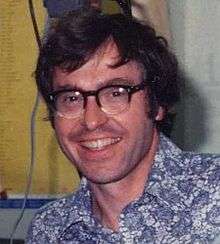Chadwick A. Tolman
Chadwick A. Tolman (born 1938) is an American chemist. He obtained his B.S. in Chemistry from Massachusetts Institute of Technology. He earned his Ph.D. in Chemistry as a microwave spectroscopist from U.C. Berkeley under the guidance of William Dulaney Gwinn.[1]
Chadwick Alma Tolman | |
|---|---|
 Tolman in 1976 | |
| Born | October 1938 (age 81) Salt Lake City, Utah |
| Citizenship | United States |
| Alma mater | Massachusetts Institute of Technology, University of California - Berkeley |
| Known for | Tolman cone angle, Tolman electronic parameter, Selective oxidation of organics, Global Warming |
| Awards | Delaware Audubon Conservation Award (2009) |
| Scientific career | |
| Fields | Inorganic chemistry |
| Institutions | DuPont Central Research, Delaware Technical & Community College, University of Delaware, National Science Foundation, National Academy of Science |
| Doctoral advisor | William Dulaney Gwinn |
He joined DuPont Central Research in 1965.[2] His early work was on late transition metal complexes with phosphorus ligands. The Tolman cone angle and Tolman electronic parameter[3] are named after him. In 1972, he proposed the 16 and 18 electron rule, extending Irving Langmuir's 18-Electron rule to include the many examples of stable 16 electron square planar d8 complexes.[4] Later work focused on the activation of C-H bonds by transition metal complexes[5][6] and free radical oxidation of cyclohexane for the production of adipic acid, an intermediate in the manufacture of nylon.[7][8]
Tolman was instrumental in the founding of the Delaware Science Alliance and took a year's leave of absence from DuPont to serve as Chair of the Coordinating Committee to help make the Alliance self-sustaining.[9] The primary goal of the Science Alliances was to link scientists interested in education to teachers looking for help in the classroom. Programs include an Elementary Science Olympiad, workshops for volunteers and elementary teachers, summer fellowships in local industry for secondary teachers, and classroom visits and demonstrations by industrial scientists.
Upon retirement from DuPont in 1996, Tolman taught at Delaware Technical & Community College and University of Delaware for a year before joining the National Science Foundation as a program officer in the Chemistry Division. That was followed by two years at the National Academy of Science in the Division of Earth and Life Sciences. His work there included studies and major reports on air pollution and air quality management.[10]
Tolman has followed and communicated about climate change issues for over 20 years. He writes a monthly electronic blog, Climate Change News.[11] He helped write the Statement of Conscience on the Threat of Global Warming/Climate Change for the Unitarian Universalist Association which was adopted by their General Assembly in 2006.[12]
Tolman serves on a number of advisory committees. He chairs the Energy Committee of the Delaware Chapter of the Sierra Club, and is a member of the Advocacy Committee of the Delaware Nature Society. He is on the Energy Committee of the Delaware League of Women Voters, and the Climate Change Task Force of the U.S. League of Women Voters, where he helped write the Toolkit for Climate Change Action [13] He serves on the Greenhouse Gas Reduction Advisory Committee and the Sea Level Rise Advisory Committee of the State of Delaware.
Tolman was presented the Delaware Audubon Conservation Award at the Delaware Audubon Society Annual Meeting on October 9, 2009.[14]
References
- Thesis: The Microwave Spectrum and Vibration-Rotation Interaction in 1,1-Difluorocyclopentane
- "Dr. Chad Tolman". C. A. Tolman. Archived from the original on 2011-08-13. Retrieved 2011-03-21.
- Tolman, C. A. (1977). "Steric effects of phosphorus ligands in organometallic chemistry and homogeneous catalysis". Chem. Rev. 77 (3): 313–348. doi:10.1021/cr60307a002.
- Tolman, C. A. (1972). "The 16 and 18 electron rule in organometallic chemistry and homogeneous catalysis". Chem. Soc. Rev. 1 (3): 337. doi:10.1039/CS9720100337.
- S. D. Ittel, C. A. Tolman, A. D. English, and J. P. Jesson, "The Chemistry of 2-Naphthyl bis[bis(dimethylphosphino)ethane] Hydride Complexes of Fe, Ru, and Os. 2. Cleavage of sp and sp3 C-H, C-O, and C-X Bonds. Coupling of Carbon Dioxide and Acetonitrile," J. Am. Chem. Soc., 100, 7577 (1978).
- C. A. Tolman, S. D. Ittel, A. D. English, and J. P. Jesson, "Chemistry of 2-Naphthyl- bis[bis(dimethylphosphino)ethane] Hydride Complexes of Iron, Ruthenium, and Osmium. 3. Cleavage of sp2 C-H Bonds," J. Am. Chem. Soc., 101, 1742 (1979).
- Tolman, C. A.; Druliner, J. D.; Nappa, M. J.; Herron, N.; Alkane Oxidation Studies in Du Pont's Central Research Department; in Act. Funct. Alkanes (1989), 303–60, edited by Craig L Hill
- Tolman, C. A.; Druliner, J. D.; Krusic, P. J.; Nappa, M. J.; Seidel, W. C.; Williams, I. D.; Ittel, S. D. Catalytic conversion of cyclohexylhydroperoxide to cyclohexanone and cyclohexanol, Journal of Molecular Catalysis (1988), 48(1), 129–48
- John W. Collette, Sharon K. Hake, and Robert D. Lipscomb; The Du Pont Honors Workshop: A Successful Industry-School Partnership, Chapter 6, pp 55–65 in Partnerships in Chemical Research and Education; ACS Symposium Series, Vol. 478, ISBN 978-0-8412-2173-4, November 18, 1992
- Committee on Review and Evaluation of the Army Chemical Stockpile Disposal Program; National Research Council (24 November 1999). Tooele Chemical Agent Disposal Facility: Update on National Research Council Recommendations. National Academies Press. ISBN 978-0-309-06882-6.
- "CLIMATE CHANGE NEWS". Retrieved 19 February 2016.
- "Threat of Global Warming/Climate Change". UUA.org. Retrieved 19 February 2016.
- (http://participate.lwv.org/c/9217/t/6398/p/salsa/web/common/public/content?content_item_KEY=3766), posted on the web in June 2010.
- Delaware Audubon Society; Inc. "Delaware Audubon – Conservation Award 2009". Archived from the original on 3 March 2016. Retrieved 19 February 2016.
External links
| Wikimedia Commons has media related to Chadwick A. Tolman. |